James Maliszewski's Blog, page 107
June 26, 2022
Pulp Fantasy Library: Witch of the Demon Seas
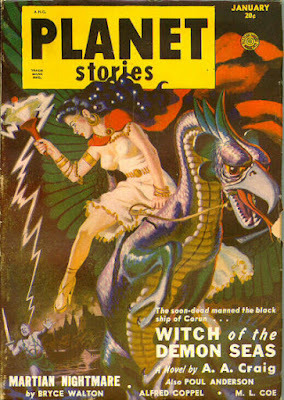 I frequently reflect on my own lack of industry, especially when compared to nearly all of the writers I discuss in my Pulp Fantasy Library posts. These energetic men and women cranked out exciting stories by the ream – so many, in fact, that they sometimes had to resort to using a variety of noms de plume to ensure the magazines would publish their submissions (many of which had policies, formal or informal, against the inclusion of more than one story by the same author in a single issue).
I frequently reflect on my own lack of industry, especially when compared to nearly all of the writers I discuss in my Pulp Fantasy Library posts. These energetic men and women cranked out exciting stories by the ream – so many, in fact, that they sometimes had to resort to using a variety of noms de plume to ensure the magazines would publish their submissions (many of which had policies, formal or informal, against the inclusion of more than one story by the same author in a single issue). I bring this up because this is precisely what happened in the case of "Witch of the Demon Seas," which first appeared in the January 1951 issue of Planet Stories. Though credited to "A.A. Craig," the yarn is actually the handiwork of Poul Anderson, another of whose stories is featured in the same issue under his usual byline. Like many pulp fictioneers, Anderson had an incredible work ethic: sixteen of his short stories and novellas were published the same year as "Witch of the Demon Seas." It's difficult not to feel inadequate when faced with such a remarkable output.
Though nowadays Anderson is most remembered for his science fiction, notably his tales of Nicholas Van Rijn, David Falkayn, and, of course, Dominic Flandry, he was also an accomplished writer of fantasy. Three Hearts and Three Lions is perhaps the best known of his fantasies, at least for players of roleplaying games, but The Broken Sword is, in my opinion, equally worthy of admiration (both appear in Gary Gygax's Appendix N, for what it's worth). Pulp writers had to be omnivorous if they wanted to make a living at writing, hence the existence of stories, such as this one, that might broadly be described as "fantasy" (or perhaps sword-and-planet, which was the bread and butter of Planet Stories during its 71-issue run).
Regardless, "Witch of the Demon Seas" certainly takes place on another world, one whose surface is almost entirely covered by water. What civilization exists can be found on numerous island kingdoms, such as the Thalassocracy of Achaera, whose ruler is Khroman the Conqueror. Khroman is "a huge man, his hair and square-cut beard jet-black despite middle age, the strength of his warlike youth still in his powerful limbs." He's also honorable, which we learn early in the story, when he tells his advisor, Shorzon the Sorcerer, that he intends to treat his recently defeated enemy, the fair-haired pirate Corun, with respect, as he is "the bravest enemy Achaera ever had."
When Khroman interrogates him, Corun reveals much about his origins and the reasons for his turn to piracy. Come to think of it, the interrogation reveals a fair bit about Khroman as well.
Khroman stared at him in puzzlement. "But why did you ever do it?" he asked finally. "With your strength and skill and cunning, you could have gone far in Achaera. We take mercenaries from conquered provinces, you know. You could have gotten Achaeran citizenship in time."
"I was a prince of Conahur," said Corun slowly. "I saw my land invaded and my folk taken off as slaves. I saw my brothers hacked down at the battle of Lyrr, my sister taken as concubine by your admiral, my father hanged, my mother burned alive when they fired the old castle. They offered me amnesty because I was young and they wanted a figurehead. So I swore an oath of fealty to Achaera, and broke it the first chance I got. It was the only oath I ever broke, and still I am proud of it. I sailed with pirates until I was big enough to master my own ships. That is enough of an answer."
"It may be," said Khroman slowly. "You realize, of course, that the conquest of Conahur took place before I came to the throne? And that I certainly couldn't negate it, in view of the Thalassocrat's duty to his own country, and had to punish its incessant rebelliousness?"
"I don't hold anything against you yourself, Khroman," said Corun with a tired smile. "But I'd give my soul to the nether fires for the chance to pull your damned palace down around your ears!"
"I'm sorry it has to end this way," said the king. "You were a brave man. I'd like to drain many beakers of wine with you on the other side of death." He signed to the guards. "Take him away."
Upon hearing this, Shorzon takes an interest in Corun, for reasons that soon become clear. Together with his daughter, Chryseis, the story's titular witch, he visits the pirate in his solitary cell. The sorcerer then offers him "life, freedom—and the liberation of Conahur!" Naturally, Corun doubts the wizard's sincerity, but Chryseis, a remarkable beauty, reassures him, "You can help us with a project so immeasurably greater than your petty quarrels that anything you can ask in return will be as nothing. And you are the one man who can do so."
"What do you want?"
"Your help in a desperate venture," said Chryseis. "I tell you frankly that we may well all die in it. But at least you will die as a free man—and if we succeed, all the world may be ours."
"What is it?" he asked hoarsely.
"I cannot tell you everything now," said Shorzon. "But the story has long been current that you once sailed to the lairs of the Xanthi, the Sea Demons, and returned alive. Is it true?"
"Aye." Corun stiffened, with sudden alarm trembling in his nerves. "Aye, by great good luck I came back. But they are not a race for humans to traffic with."
"I think the powers I can summon will match theirs," said Shorzon. "We want you to guide us to their dwellings and teach us the language on the way, as well as whatever else you know about them. When we return, you may go where you choose. And if we get their help, we will be able to set Conahur free soon afterward."
Corun shook his head. "It's nothing good that you plan," he said slowly. "No one would approach the Xanthi for any good purpose."
"You did, didn't you?" chuckled the wizard dryly. "If you want the truth, we are after their help in seizing the government of Achaera, as well as certain knowledge they have."
"If you succeeded," argued Corun stubbornly, "why should you then let Conahur go?"
"Because power over Achaera is only a step to something too far beyond the petty goals of empire for you to imagine," said Shorzon bleakly. "You must decide now, man. If you refuse, you die."
This is the proverbial offer that one cannot refuse, so, with some trepidation, Corun agrees. Shorzon and Chryseis then lead him to a fully-crewed vessel that will take them to the Xanthi, a race of inimical fish-men with a history of warring against the other peoples of the world. The ship leaves Achaera – without the knowledge of Khroman, I might add! – on a quest whose ultimate objective, Corun suspects, is far from virtuous. For the moment, though, he does not care, as he only wishes "to live! To die, if he must, under the sky!"
"Witch of the Demon Sea" is a delightful romp, filled with monsters, magic, sorcery, and swordplay. The characters, starting with Corun himself, are somewhat archetypal, let us say, but Anderson tells the story with such energy and enthusiasm that I soon didn't care. The story is interesting, too, because it contains elements that could be described as "secret sci-fi," thereby further muddying the waters regarding how to classify this yarn. For myself, I prefer to classify it as "fun" and leave it at that.
June 24, 2022
Simplifying BRP Combat?
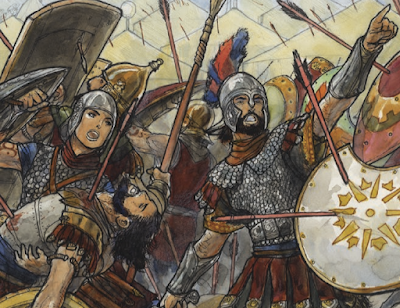 I'd like to call upon the wisdom of readers with long experience playing games derived from Chaosium's Basic Role-Playing. Lately, I've been looking with less judgmental eyes on RuneQuest and finding within it – I speak of its 1979 second edition rather than its current iteration – worthy of greater admiration, both for its setting and for its rules, both of which really were ahead of their time.
I'd like to call upon the wisdom of readers with long experience playing games derived from Chaosium's Basic Role-Playing. Lately, I've been looking with less judgmental eyes on RuneQuest and finding within it – I speak of its 1979 second edition rather than its current iteration – worthy of greater admiration, both for its setting and for its rules, both of which really were ahead of their time.Nevertheless, one aspect of RQ continues to bedevil me, namely combat. BRP combat, particularly in its RuneQuest iteration, is much more fiddly than I'd like. The combination of strike ranks, attack rolls, defense rolls, criticals, impales, fumbles, hit locations, and armor absorption is simply too much for my feeble mind to handle. A lifetime of playing Dungeons & Dragons has, by and large, mentally conditioned me for fast and simple combats, each round of which can be resolved with only a couple of dice rolls and the most basic of math. RuneQuest is several steps more complex than I enjoy. And yet I can't deny that there can be many benefits from complexity. I sometimes mention that, a few years ago, I had the opportunity to play Rolemaster with a referee who knew its rules well and helped make the process of using them relatively painless for me. As a consequence, I re-evaluated my older assessment of them as too arcane for my tastes. Perhaps the same is true of RuneQuest's combat system?
That's why I'd like to hear from anyone who's refereed an RQ campaign for some length. What was your experience with combat? Did you find a way to make it run more quickly and smoothly? Is there some crucial insight into its workings that might help me overcome my concern about its fiddliness? Alternately, is there some iteration of BRP that manages to streamline combat without losing too much detail? I know that OpenQuest is well regarded in some quarters, but I haven't kept up with its development since its original release. Is that still a good option or are there others I should consider? Shower me with your thoughts on this, please.
June 22, 2022
Retrospective: Operation: Rapidstrike!
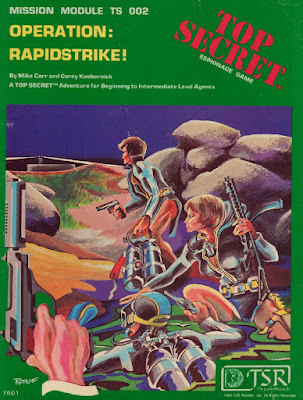 I have many fond memories of TSR's espionage roleplaying game, Top Secret. My friends and I regularly played it as part of our rotation of RPGs that weren't Dungeons & Dragons. Though Top Secret is not without its problems, we had a lot of fun with it. I typically acted as the Administrator, which meant that it fell to me to come up with the missions for the player character agents. This rarely bothered me; I'd seen enough espionage-related movies and TV shows to have ready sources of ideas.
I have many fond memories of TSR's espionage roleplaying game, Top Secret. My friends and I regularly played it as part of our rotation of RPGs that weren't Dungeons & Dragons. Though Top Secret is not without its problems, we had a lot of fun with it. I typically acted as the Administrator, which meant that it fell to me to come up with the missions for the player character agents. This rarely bothered me; I'd seen enough espionage-related movies and TV shows to have ready sources of ideas.
Like many referees, though, I sometimes appreciated having someone else do the heavy lifting for me, which is where pre-made adventures like Operation: Rapidstrike! came in. Written by Mike Carr (of In Search of the Unknown fame) and Corey Koebernick (husband of the Jean Wells) and published in 1980, Rapidstrike! is the first adventure module sold separately from the Top Secret boxed set. Consequently, I was quite keen to pick it up after its release, hoping that it would make a nice change of pace from my own "original" scenarios.
The character agents are assigned to infiltrate a pharmaceutical research facility located on an island off the coast of Africa. The facility is owned by a wealthy Frenchwoman, Geneviève Larreau, with a history of anti-Western agitation. Also located on the island is Felix Fendelmann, a Nobel Prize-winning Swiss scientist who disappeared from his laboratory several months previously. Reliable sources suggest that Fendelmann is developing Zucor, "a mind-expanding drug of incredible power," which Larreau hopes to use to undermine the nations of Europe and North America. All in all, it's a fairly typical plot for the pulpy spy thrillers of the era, not too different, for example, from 1969's Bond outing, On Her Majesty's Secret Service.
As an adventure, Operation: Rapidstrike! is, in effect, a dungeon crawl, with the characters sneaking from room to room of Larreau's facility, fighting her guards and evading the traps placed therein. As I would later discover, this is more or less the template of most Top Secret adventures published by TSR. There's not a lot of espionage to be had here; it's mostly an infiltration and elimination module, with the requisite amount of gunplay and associated mayhem. I don't think any of us much minded at the time, since Top Secret's various combat-related sub-systems were among its attractions for us. Likewise, the module was originally intended, as Carr explains in his foreword, for use at a GenCon tournament, which necessitated a fairly straightforward – and deadly – scenario. (I continue to wonder how the history of the hobby might have changed had fewer of TSR's published modules not originated in the tournament scene.)
Nowadays, I'd judge Operation: Rapidstrike! a fair bit more harshly than would my younger self. As I said, it's a rather limited, smash-and-grab situation, more like a special operations mission than something calling for the world's greatest spies. Mind you, that's the eternal problem with espionage roleplaying games: how do you incorporate more than a couple of player characters into a campaign without its becoming a mess? Parties of dungeon explorers make sense, but spies? Not so much, hence the inevitable morphing of the game's ostensible genre into something more closely resembling SEAL Team Six (or, more likely, the A-Team) than anything from James Bond or The Man from U.N.C.L.E.
Despite these criticisms, I nevertheless retain an affection for Rapidstrike! My friends and I enjoyed ourselves while using it, which is the ultimate seal of approval when it comes to entertainment of this sort. Nowadays, I think the module's main value might be in some of its artwork, created by the likes of such legends as Jeff Dee, David LaForce, Bill Willingham, Jim Roslof, and Erol Otus. Otus, in particular, offers up some truly memorable illustrations, such as this one depicting the effects of the drug Zucor on any agent foolish enough to ingest it. Good times!

June 21, 2022
White Dwarf: Issue #39
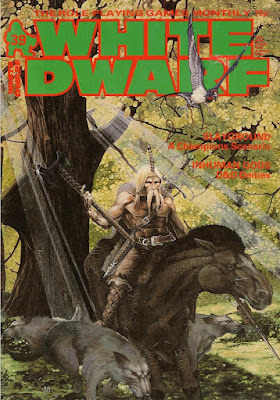 Issue #39 (March 1989) of White Dwarf sports not only a cover by Nicholas Bibby (who also did last month's cover) but also a new cover logo and non-justified text, the latter of which makes its articles much easier on the eyes (or mine, at any rate). Another addition is a book review column by Dave Langford. In addition, Ian Livingstone mentions in his editorial that this issue is just the start of changes to the magazine. Future issues will include more original fiction, a comic strip, and a column devoted to boardgames.
Issue #39 (March 1989) of White Dwarf sports not only a cover by Nicholas Bibby (who also did last month's cover) but also a new cover logo and non-justified text, the latter of which makes its articles much easier on the eyes (or mine, at any rate). Another addition is a book review column by Dave Langford. In addition, Ian Livingstone mentions in his editorial that this issue is just the start of changes to the magazine. Future issues will include more original fiction, a comic strip, and a column devoted to boardgames.
Kicking off the issue is part one of "Inhuman Gods" by Phil Masters. The article presents a half-dozen gods for various nonhuman D&D monsters, such as the aaracokra from the Fiend Folio and the desert raiders from issue #12 of White Dwarf. This is the kind of article I ate up when I was younger and, even now, I can appreciate the creativity that went into imagining the types of deities "lesser" species must worship. Nowadays, my natural inclination is toward greater simplicity when it comes to gods and cosmological questions, so I don't favor the "a god for every monster" approach employed here.
"Open Box" reviews four of TSR's "Endless Quest" choose-your-own-adventure books, including Dungeon of Dread. The reviewer, Marcus L. Rowland, judges them individually, with the lowest receiving 5 out of 10 and the highest 7 out of 10. All, he says, are clearly geared toward younger readers and suffer from "a surfeit of lucky coincidences, cute talking animals, and lousy dialogue." I can't really disagree. Also reviewed is Citybook 1 from Flying Buffalo (7 out of 10) and four Traveller adventures. The first two are by FASA: Rescue on Galatea (6 out of 10) and The Trail of the Sky Raiders (8 out of 10). The other pair are from GDW: Prison Planet (5 out of 10) and Double Adventure 6: Divine Intervention/Night of Conquest (9 out of 10). I'll readily grant that Prison Planet isn't among GDW's best work, but I likely wouldn't judge it as low the reviewer, Andy Slack.
"Runeblades" by Dave Morris presents rules for creating rune weapons for Chaosium's non-Gloranthan RuneQuest setting, Questworld. I can't say it impressed me much, since it's effectively just a collection of magic swords, none of which stood out as unique in the annals of RPG history. Similarly, part four of "An Introduction to Traveller" by Andy Slack is a bit of a letdown. This installment focuses on campaigns, specifically the kinds of decisions a referee must make before starting a new Traveller campaign. I suppose an utter neophyte might find its discussions of size, scope, the presence of Earthlike worlds, alien races genuinely insightful. For myself, it's more of the same I've read many times in many different places – too bad, as Slack often produced some of the best Traveller material to be found anywhere.
"Slayground" by Marcus L. Rowland is a Champions scenario set at a London fun fair, where three supervillains are causing mayhem. The main attraction here (pun slightly intended) is the environment, which offers unique options for superheroic fisticuffs. It's also interesting to see a Champions adventure in the pages of WD, something I can't recall being a common feature. "Stand By to Repel Boarders" by Andrew Miller is a good, if short, article about starship security in Traveller. Miller discusses airlocks and iris valves, as well as tactics for fighting in enclosed spaces aboard spacegoing vessels. It's a niche article but a useful one, especially if your Traveller adventures sometimes include a little Snapshot-style action.
"The Daughter of Danu" by Alan E. and Charles M. Paull is an AD&D adventure that makes use of the faerie information presented in issues #37 and #38. The scenario is geared toward characters of levels 2-4 and concerns the troubles experienced by a rural village beset by two different tribes of warring goblins, each of which is trying to curry the favor of Black Annis. It's a classic set-up, trite even, but the faerie lore details add just enough spice to make it seem fresh.
Dave Langford's premier "Critical Mass" column reviews several science fiction and fantasy books, the most significant of which are Arthur C. Clarke's 2010: Odyssey Two, Isaac Asimov's Foundation's Edge, and Robert Heinlein's Friday. Langford likes the first book and has mixed feelings about the second two. Having read all three, I can't say I disagree with his assessment, though I think I probably disliked Friday more than he seems to have. Reading this column is fascinating, primarily because it engenders strange feelings of nostalgia of the time before science fiction and (especially) fantasy literature had become as big as they are today. Also, am I really old enough to remember new books by Clarke, Asimov, and Heinlein? Yikes.
"A Day in the Life of a Monster" by Lewis Pulsipher is an examination of monster intelligence and how it might influence their motivations. Pulsipher even includes a simple system to aid the referee in deciding the goals of a monster (or group of monsters). "Monster Mash" presents two new monsters for use with RuneQuest and "Non-Player Characters" by Roger and Georgia Moore presents three detailed NPCs for use with AD&D (including Konun the Halfling (the joke should be obvious).
All in all, it's a good issue, with lots of varied content. This is quite close to what I think of when I remember White Dwarf: a mix of long and short articles for use with many games but with D&D, RuneQuest, and Traveller predominating, as God intended. What's not to like?
June 20, 2022
Pulp Fantasy Library: The Planet of the Dead
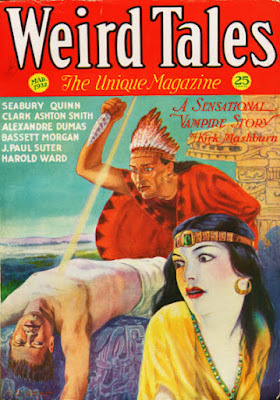 I've been in something of a Clark Ashton Smith mood lately, re-reading not only his more well-known tales, such as those of the Hyperborea or Zothique cycles, but some of his less celebrated ones. "The Planet of the Dead," first appearing in the March 1932 issue of Weird Tales, arguably falls into this latter category and it's not difficult to understand why.
I've been in something of a Clark Ashton Smith mood lately, re-reading not only his more well-known tales, such as those of the Hyperborea or Zothique cycles, but some of his less celebrated ones. "The Planet of the Dead," first appearing in the March 1932 issue of Weird Tales, arguably falls into this latter category and it's not difficult to understand why.
Much of Smith's fictional output is decidedly lacking when it comes to plot, especially when compared to his fellow pulp writers. He is much more focused on evoking feelings in his readers than on presenting a straightforward narrative. That's not to say he has no interest in action, but it often takes a backseat to mood. That's certainly the case in "The Planet of the Dead," whose story, while present, is much less important than the emotions Smith hoped to conjure with it.
To get a sense of what I mean, consider the opening of the story:
By profession, Francis Melchior was a dealer in antiques; by avocation he was an astronomer. Thus he contrived to placate, if not to satisfy, two needs of a somewhat complex and unusual temperament. Through his occupation, he gratified in a measure his craving for all things that have been steeped in the mortuary shadows of dead ages, in the dusky amber flames of long-sunken suns; all things that have about them the irresoluble mystery of departed time. And through his avocation, he found a ready path to exotic realms in further space, to the only spheres where his fancy could dwell in freedom and his dreams could know contentment. For Melchior was one of those who are born with an immedicable distaste for all that is present or near at hand; one of those who have drunk too lightly of oblivion and have not wholly forgotten the transcendent glories of other aeons, and the worlds from which they were exiled into human birth; so that their furtive, restless thoughts and dim, unquenchable longings return obscurely toward the vanishing shores of a lost heritage. The earth is too narrow for such, and the compass of mortal time is too brief; and paucity and barrenness are everywhere; and in all places their lot is a never-ending weariness.A reader is either immediately entranced by prose of this sort or is put off by it; there's rarely a middle ground. I've sometimes described Smith's word as incantatory, though, in this case, I'd probably use the word hypnotic. The passage doesn't simply introduce us to the tale's protagonist, whose name recalls (not coincidentally, I suspect) one of the Magi who followed a star to the birthplace of Christ, but also acclimates the reader to its tone – contemplative, melancholic, wistful.
Melchior, we learn, has achieved some measure of success as a dealer in antiques, enough that he doesn't worry much about material needs. At the same time, "he had never cared to marry," "had made no intimate friends; and he lacked many of the interests which, in the eyes of the average person, are supposed to characterize a normal human being." I hesitate to suggest this sounds more than a little bit like Smith himself, but it does, doesn't it?
In any event, Melchior devotes himself to studying
one minute star in a wide-flung constellation south of the Milky Way. It was barely discernible to the naked eye; and even through his telescope, it gave an impression of cosmic solitude and remoteness such as he had never felt in any other orb. It allured him more than the moon-surrounded planets or the first-magnitude stars with their flaming spectra; and he returned to it again and again, forsaking for its lonely point of light the marvelous manifold rings of Saturn and the cloudy zone of Venus and the intricate coils of the nebula of Andromeda.
One evening, the star seems to look "a little larger and brighter than usual" and viewing it elicits an excitement within Melchior that makes him feel as if "he was peering downwards into a vast, vertiginous abyss." Before long, he loses consciousness and, when he awakes, he finds himself in another place, one at once alien and familiar. After a few moments of confusion, he realizes the truth.
He [was] Antarion, a renowned poet of the land of Charmalos, in the elder world that was known to its living peoples by the name of Phandiom, had gone on a brief journey to a neighboring realm. In the course of this journey, a distressing dream had befallen him — the dream of a tedious. unprofitable life as one Francis Melchior, in a quite unpleasant and peculiar sort of planet, lying somewhere on the farther side of the universe. He was unable to recall exactly when and where he had been beset by this dream; and he had no idea how long it had lasted: but at any rate, he was glad to be rid of it, and glad that he was now approaching his native city of Saddoth, where dwelt in her and splendid palace of past aeons the beautiful Thameera. whom he loved. Now, once more, after the obscure clouding of that dream, his mind was full of the wisdom of and his heart was illumed by a thousand memories of Thameera; and was darkened at whiles by an old anxiety concerning her.
Not without reason had Melchior been fascinated by things antique and by things that are far away. For the world wherein he walked as Antarion was incomputably and the ages of its history were too many for remembrance: and the towering obelisks and piles along the paven road were the high tombs, the proud monuments of its immemorial dead, who had come to outnumber infinitely the living. In more than the pomp of earthly kings, the dead were housed in Phandiom; and their cities loomed insuperably vast, with never-ending streets and prodigious spires, above those lesser abodes wherein the living dwelt. And throughout Phandiom the bygone years were a tangible presence, an air that enveloped all; and the people were steeped in the crepuscular gloom of antiquity; and were wise with all manner of accumulated lore; and were subtle in the practise of strange refinements, of erudite perversities, of all that can shroud with artful opulence and grace and variety the bare uncouth cadaver of life, or hide from mortal vision the leering skull of death. And here, in Saddoth, beyond the domes and terraces and columns of the huge necropolis, a necromantic flower wherein forgotten lilies live again, there bloomed the superb and sorrowful loveliness of Thameera.
This is a common theme in Smith's work. Whether by means of sorcery, science, or the transmigration of souls, a man of our Earth realizes that he belongs elsewhere. Earth is, at best, a place of exile, if not torment, and he only truly comes into himself when somehow liberated from the dreary. humdrum existence of "everyday" life. There's a powerful, mournful longing in these tales, as the protagonist grapples with the fact that it is only by leaving behind all that he knows – or thought he knew – that he can ever experience the elation for which his soul was made. It's heady stuff, particularly for any reader who might himself have felt that he, too, did not fit in.
Smith might well be called a romantic. However, he was not a sentimentalist and so what happens to Melchior – which is to say, Antarion – now that he has returned "home" is not without its own share of sadness. That's what elevates "The Planet of the Dead" beyond mere wish fulfillment and makes a story that while far from Smith's best, is nevertheless well worth reading.
June 16, 2022
Retrospective: Curse of Xanathon
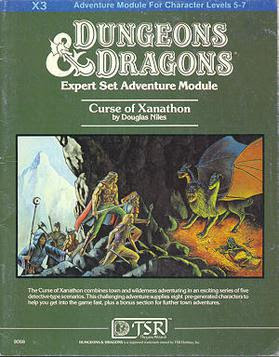 I have strangely fond memories of the Dungeons & Dragons adventure module, Curse of Xanathon. I say "strangely fond," because it's not a very good module, even if one grades it on a curve, many people do. My personal fondness stems not from the adventure itself, but from the fact that it's the first D&D module a member of my extended family purchased for me.
I have strangely fond memories of the Dungeons & Dragons adventure module, Curse of Xanathon. I say "strangely fond," because it's not a very good module, even if one grades it on a curve, many people do. My personal fondness stems not from the adventure itself, but from the fact that it's the first D&D module a member of my extended family purchased for me.
Though my love of D&D and other RPGs was well known to my grandparents, aunts, uncles, and cousins, none of them really understand this new obsession of mine. Even my favorite aunt, who'd introduced me to Star Trek, taken me to see Star Wars, and got me Darren McGavin's autograph, took a while to fathom what roleplaying games were all about. That's why her gift of Curse of Xanathon to me on my birthday still sticks with me decades later.
Published in 1982 and written by Douglas Niles, Curse of Xanathon – or The Curse of Xanathon, since the interior text is inconsistent on this point – is the third module written for use with the D&D Expert Set. The suggested level range is 5–7, which I consider a mechanical sweet spot for D&D. The module opens with "Notes for the Dungeon Master" that are well worth examining, since they shed some light on its shortcomings:
The Curse of Xanathon is an unusual module, in that much of the players’ actions will be in the form of detective work, as they try to discover clues to the problem plaguing the town. Once they have located these clues, they will have to decide on a proper course of action. If they make wrong decisions, they could conceivably waste much time and obtain no results. You, as the DM, will need a careful touch to keep the players on the right track without making solutions and objectives too obvious.
I find it remarkable that, even as late as 1982, the conflation of "player" and "player character" is still occurring. That aside, you should already be able to see the source of the module's problems. Niles explicitly presents Curse of Xanathon as an investigative scenario, in which the characters' actions depend on the discovery of clues. Because scenarios of this sort are prone to going awry, he counsels the DM to "keep the players on the right track," even he warns against "making solutions and objectives too obvious."
Niles goes on:
Much information is included in the various scenarios, and astute players will no doubt be able to determine the proper course of action at each stage of the adventure. If a group of players is unfamiliar with this type of detective game, they may become frustrated or disinterested. The DM is encouraged to offer additional clues whenever these would seem to be necessary. This can be handled in a number of ways. For example, the High Priest of Forsetta, who moves around in a beggar’s disguise, is introduced in Scenario 1. The DM should feel free to use this character whenever necessary as a source of information and guidance to the party. He will never join in any adventuring, however!
Hard as I might wish to do so, I find this paragraph difficult to defend. While I suspect that all but the most intransigent referees have occasionally thrown a metaphorical bone in the direction of hapless players from time to time, the use of an non-player character as suggested here is a very bad practice to encourage, despite his final admonition. Curse of Xanathon isn't quite a railroad, as the term is traditionally used, but the High Priest is a railroad conductor who regularly pops up throughout the scenario to nudge the characters in the "right" direction.
The mystery the characters must investigate is the strange behavior of Duke Steven Rhoona, a previously good and just ruler, who has lately been issuing nonsensical decrees, such as that all taxes must be paid in beer rather than gold and that all horses must be ridden backwards, with the rider facing the horse's tail. His subjects fear the duke has gone mad, but the truth is he's fallen under the titular curse of the Chaotic priest, Xanathon. Xanathon is an agent of a nearby nation; he's been sent to foment rebellion in the duchy as a prelude to invasion.
As a premise, it's a perfectly fine one for an adventure focusing on investigation and intrigue and Niles does provide a number of useful tools for the referee to aid in this. For example, there are tables of rumors and tavern names, as well as an overview of the businesses and NPCs of the duchy's capital, not to mention a map. Likewise, there are five distinct sections of the adventure, each of which deals with finding or follow up on certain clues. These sections each take place in a different locale, with their own unique elements and denizens, like the Chaotic shrine and the ducal palace. The guts of Curse of Xanathon are solid, evocative of earlier location-based adventures.
However, it's clear that a sea change has overcome module design at TSR by this point. A stronger sense of "plot" has begun to creep in, along with narrative crutches like the aforementioned High Priest NPC, who pops in and out of the adventure as needed to ensure the characters keep heading toward the inevitable resolution of their tasks. This isn't full-blown Dragonlance-style "story," but it's certainly heading in that direction. At the time I was given Curse of Xanathon, none of this was at all obvious to me. Re-reading now, though, it's impossible not to see the signs of the impending Hickman Revolution and all that it would eventually entail.
June 15, 2022
White Dwarf: Issue #38
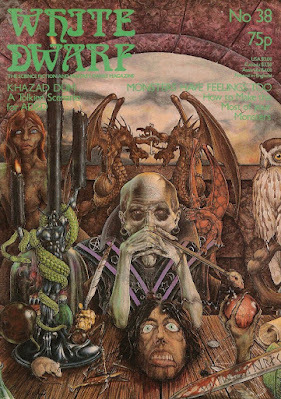 Issue #38 of White Dwarf (February 1983) features a cover by Nicholas Bibby, an artist who'd later go on to become a sculptor for Asgard and Citadel Miniatures. The issue begins with part three of Andy Slack's "An Introduction to Traveller," which focuses on scenarios. Interestingly, Slack presents patrons as central to the idea of scenarios in Traveller, which certainly makes sense, given the publishing history of the game. Likewise, he emphasizes the utility of what he calls the "improvisational style" of refereeing – a kind of "just in time" approach to coming up with details – as a good way to keep a campaign moving briskly. Perhaps I am unduly prejudiced by my own preference for such an approach, but I found Slack's advocacy a refreshing change of pace from most articles on the subject of refereeing, most of which emphasize exhaustive preparation beforehand as the norm.
Issue #38 of White Dwarf (February 1983) features a cover by Nicholas Bibby, an artist who'd later go on to become a sculptor for Asgard and Citadel Miniatures. The issue begins with part three of Andy Slack's "An Introduction to Traveller," which focuses on scenarios. Interestingly, Slack presents patrons as central to the idea of scenarios in Traveller, which certainly makes sense, given the publishing history of the game. Likewise, he emphasizes the utility of what he calls the "improvisational style" of refereeing – a kind of "just in time" approach to coming up with details – as a good way to keep a campaign moving briskly. Perhaps I am unduly prejudiced by my own preference for such an approach, but I found Slack's advocacy a refreshing change of pace from most articles on the subject of refereeing, most of which emphasize exhaustive preparation beforehand as the norm.Speaking of Traveller, "Open Box" begins with an extensive review of The Traveller Book, which I have previously called "the perfect RPG book." The reviewer, Phil Masters, thought well of it, too, though not as well as I do, as he gave it "only" a 9 out of 10. Also reviewed is Dicing With Dragons, a book – one of several released around this time – intended to introduce newcomers to the still largely unknown hobby of roleplaying. I own a copy and think it's a pretty good example of its type. The reviewer, Marcus L. Rowland, agreed and gave it a score of 9 out of 10. Finally, there's a joint review of Traitor and The Spirit Stones, two scenarios for use with Chaosium's Thieves' World. Until I read this review (which judges both 7 out of 10), I'd forgotten about the existence of these adventures, which I never owned but whose advertisements I remember from old FASA catalogs.
"Faerie Denizens" by Alan E. Paul is a follow-up to last month's "Faeries" article. Paull presents a collection of nine new AD&D monsters drawn from British and Celtic folklore, ranging from redcaps to spriggans to phookas. It's an excellent assortment of new monsters, varied in the abilities and disposition toward non-faerie creatures. As I've said many times before, I'm a sucker for monster write-ups drawn from real world myths and legends, so I'm likely biased strongly in favor of articles of this sort. Nevertheless, I think Paull did a genuinely good job here.
"Questworld" is a very short article by Oliver Dickinson and Bob McWilliams, in which they provide an overview of the RuneQuest's oft-forgotten non-Gloranthan setting for the game. More than that, the article highlights the fact that Chaosium was actively seeking outside submissions from writers interested in developing Questworld. I've long been intrigued by this path not taken for RuneQuest, so I was glad to see this article, however short. One of these weeks I should dedicate a post or two about Questworld and its development (or lack thereof).
"Khazad Dûm" is an AD&D scenario written by Lewis Pulsipher. As its title suggests, the adventure is set in Tolkien's Middle-earth, specifically the abandoned dwarven city known to later generations as Moria. Pulsipher presents this as a beginners' scenario, complete with pregenerated characters based on those in The Fellowship of the Ring. The game stats he provides for the characters are interesting, with Gandalf being judged an 8th-level cleric – shades of Gary Gygax! – Aragorn a "ranger-paladin" hybrid, and Frodo a 2nd-level fighter, to cite just three examples. Pulsipher's version of Moria is a thoroughly D&D-ized one, with spiders, ghouls, and wights being presents alongside the more obvious goblins, orcs, and trolls. It's a simultaneously odd yet compelling vision of the place, one that rather powerfully evokes odd goulash of fantasy inspirations and influences of the era. Rather than being critical of it, I find myself charmed.
"Digital Dragons" by Noel Williams is another article that evokes the era, but in a different way. Williams opines about the ways in which personal computers might eventually prove important in the hobby. Many of his intuitions have since proven correct but it took a lot longer for them to come to pass than he probably expected in 1983. "Monsters Have Feelings Too" by Oliver MacDonald is much what you'd expect: it's an exhortation to referees to make better use of monsters by considering not just their abilities but also how they might think about the world. Accompanying the article is one possible illustration of this advice in the form of :Extracts from the Uruk-Hai Battle Manual" by Graeme Davis. It's presented as a short in-setting document that outlines the strategy and tactics to be employed by orcs under different circumstances. There are thus sections of the use of spells and traps, appropriate weapons and armor, and the use of terrain, among many other topics. It's quite well done and useful, though it's written in a clear, concise way that is at odds with my own natural conception of orcs as not being particularly deep thinkers, but your mileage may vary.
"Lords of the Spirit World" by Dave Morris provides rules for powerful spirits for use with RuneQuest. The article, though short, is a welcome one, especially in RQ games where spirit magic plays an important role. Meanwhile, "Treasure Chest" presents five new spells for AD&D, none of which really struck me as groundbreaking. Mind you, I have never been the target audience for new spells – I think AD&D already has more than enough in the Players Handbook – but, even so, these aren't anything speical.
Issue #38 of White Dwarf is a good one, at least from a nostalgia point of view. Several times while reading it I was transported back to the bygone world of four decades ago, when fantasy roleplaying still possessed a wild, untamed energy to it I don't think it's possessed in many years.
June 13, 2022
Suspense in the 1920s
 One of the fascinating things about
Call of Cthulhu
, originally released in 1981, is the way that Chaosium's early advertisements tended to, if not actually downplay its connection to the works of H.P. Lovecraft, place it on an equal footing with other elements, such its 1920s setting or a broader "investigation of the occult."
One of the fascinating things about
Call of Cthulhu
, originally released in 1981, is the way that Chaosium's early advertisements tended to, if not actually downplay its connection to the works of H.P. Lovecraft, place it on an equal footing with other elements, such its 1920s setting or a broader "investigation of the occult." Anecdotally, this approach seems to have worked. Though HPL was well known in some corners of the hobby at the time, he certainly didn't enjoy the same wide level of fame he now possesses. Given that, promoting it as a more general horror game makes sense. I know plenty of people my age whose first introduction to Lovecraft was through Call of Cthulhu, much in the way that they learned about Robert E. Howard's Conan from the pages of Marvel comics. Likewise, CoC was one of the earliest RPGs set in the 1920s, predating TSR's Gangbusters by a year (though FGU's Gangster! appeared in 1979). I know that certainly appealed to me (and still does – it's my preferred era in which to play the game).
The older I get, the more I find myself in awe of what Chaosium accomplished in the first decade of the hobby. Better late than never!
June 12, 2022
Pulp Fantasy Library: The Return of the Sorcerer
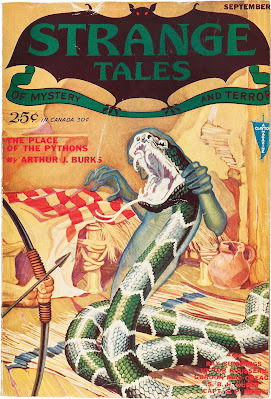 When it comes to the work of Clark Ashton Smith, my own preferences tend toward his fantasy output, particularly those set in Averoigne, Hyperborea, and Zothique. However, nearly all of Smith's work is tinged with horror, which is why it should come as no surprise that produced numerous tales which is much more explicitly horrific in nature.
When it comes to the work of Clark Ashton Smith, my own preferences tend toward his fantasy output, particularly those set in Averoigne, Hyperborea, and Zothique. However, nearly all of Smith's work is tinged with horror, which is why it should come as no surprise that produced numerous tales which is much more explicitly horrific in nature.
One of his most well known (and anthologized) horror stories is "The Return of the Sorcerer," which first appeared in the September 1931 issue of Strange Tales of Mystery and Horror. The tale is influenced by the work of H.P. Lovecraft, with the blasphemous Necronomicon playing a central role in its narrative. Smith shared a typescript of the story with HPL in early 1931, who had kind things to say about it, though he did make several suggestions for heightening its tension. Smith embraced these suggestions with enthusiasm and the result is a creditable, occasionally frightful yarn in the best tradition of the pulps.
Told in the first person, "The Return of the Sorcerer" tells the tale of Ogden, a scholar who "had been out of work for several months" and whose "savings were perilously close to the vanishing point." I find it difficult, upon reading those lines, not to think of Smith himself, who often engaged in all manner of odd jobs, including manual labor, to make ends meet. Ogden has recently applied for the position of secretary to John Carnby, an aged scholar living "at the end of a hill-top avenue in the suburbs of Oakland." Ogden's application is successful, owing to his knowledge of Arabic, which Carnby explains is absolutely essential to his own researches.
Though overjoyed at finding gainful – and potentially intellectually stimulating – employment, Ogden is nevertheless put off by Carnby himself.
He had all the earmarks of the lonely scholar who has devoted patient years to some line of erudite research. He was thin and bent, with a massive forehead and a mane of grizzled hair; and the pallor of the library was on his hollow, clean-shaven cheeks. But coupled with this, there was a nerve-shattered air, a fearful shrinking that was more than the normal shyness of a recluse, and an unceasing apprehensiveness that betrayed itself in every glance of his dark-ringed, feverish eyes and every movement of his bony hands. In all likelihood his health had been seriously impaired by over-application; and I could not help but wonder at the nature of the studies that had made him a tremulous wreck But there was something about him — perhaps the width of his bowed shoulders and the bold aquilinity of his facial outlines — which gave the impression of great former strength and a vigor not yet wholly exhausted.
His voice was unexpectedly deep and sonorous.
Carnby asks Ogden to move in with him, which he does immediately, despite his reservations – well-founded, we soon learn – about his patron.
"I have made a life-study of demonism and sorcery," he declared. "It is a fascinating field, and one that is singularly neglected. I am now preparing a monograph, in which I am trying to correlate the magical practices and demon-worship of every known age and people. Your labors, at least for a while, will consist in typing and arranging the voluminous preliminary notes which I have made, and in helping me to track down other references and correspondences. Your knowledge of Arabic will be invaluable to me, for I am none too well-grounded in this language myself, and I am depending for certain essential data on a copy of the Necronomicon in the original Arabic text. I have reason to think that there are certain omissions and erroneous renderings in the Latin version of Olaus Wormius."
Ogden "had heard of this rare, well-nigh fabulous volume but had never seen it." He had also heard of its sinister reputation as a source of "the ultimate secrets of evil and forbidden knowledge." After dinner on the first night of his employment, Carnby shows his secretary the book in question.
It was enormously old, and was bound in ebony covers arabesqued with silver and set with darkly glowing garnets. When I opened the yellowing pages, I drew back with involuntary revulsion at the odor which arose from them — an odor that was more than suggestive of physical decay, as if the book had lain among corpses in some forgotten graveyard and had taken on the taint of dissolution.
Carnby is quite keen that Ogden should translate a section of the Arabic text that is absent in the later Latin translation. This Ogden does, his rough translation being the following:
"It is verily known by few, but is nevertheless no attestable fact, that the will of a dead sorcerer hath power upon his own body and can raise it up from the tomb and perform therewith whatever action was unfulfilled in life. And such resurrections are invariably for the doing of malevolent deeds and for the detriment of other's. Most readily can the corpse be animated if all its members have remained intact; and yet there are cases in which the excelling will of the wizard hath reared up from death the sundered pieces of a body hewn in many fragments, and hath caused them to serve his end, either separately or in a temporary reunion. But in every instance, after the action hath been completed, the body lapseth into its former state."
Though Ogden deems the passage "errant gibberish," Carnby is pleased with his translation, even as he seems to become even more anxious than before. It's at this point that the reader is treated to the story's first serious intimations of horror:
I heard an indescribable slithering noise in the hall outside. But when I finished the paragraph and looked up at Carnby, I was more startled by the expression of stark, staring fear which his features had assumed — an expression as of one who is haunted by some hellish phantom. Somehow, I got the feeling that he was listening to that odd noise in the hallway rather than to my translation of Abdul Alhazred.
"The house is full of rats,' he explained, as he caught my inquiring glance. 'I have never been able to get rid of them, with all my efforts."
I spoil nothing by telling you there are no rats in Carnby's house.
"The Return of the Sorcerer," while not Smith's best work, is still an engagingly grisly tale of the dangers inherent in practicing the Black Arts. I can't quite good so far as to say the tale is fun, but there is something of a joyous ghoulishness in the building tension, as CAS provides more and more clues to the reader about just what is happening. It's the kind of story one might expect to have found in the pages of EC Comics a generation later. If that's the sort of thing you enjoy, you can't go wrong with "The Return of the Sorcerer."
June 10, 2022
High Lethality
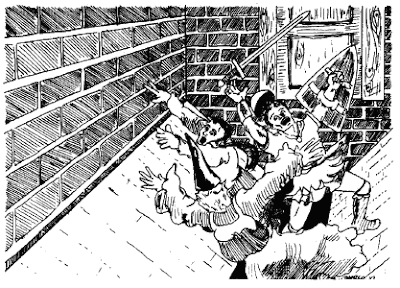 Old school roleplaying games, Dungeons & Dragons foremost among them, have a reputation for being deadly and absurdly so. Ask almost any roleplayer, young or old, about what distinguishes older editions of D&D from more contemporary ones and I'd wager that a good number of them would mention their supposed deadliness. I say "supposed," because I'm not convinced that older RPGs really are inherently deadlier than their descendants. At the same time, I do think there's something real behind this perception of high lethality; it's not simply a macho boast.
Old school roleplaying games, Dungeons & Dragons foremost among them, have a reputation for being deadly and absurdly so. Ask almost any roleplayer, young or old, about what distinguishes older editions of D&D from more contemporary ones and I'd wager that a good number of them would mention their supposed deadliness. I say "supposed," because I'm not convinced that older RPGs really are inherently deadlier than their descendants. At the same time, I do think there's something real behind this perception of high lethality; it's not simply a macho boast.Since returning to old school gaming shortly before I began this blog, I've refereed or played in a lot of different games, starting with my OD&D-derived Dwimmermount campaign. In nearly all of them, player characters died, with a RuneQuest campaign set in and around the Big Rubble being a stand-out in this regard (the campaign ended with a total party kill while fighting trolls). The level of lethality varied from game to game, though, with some (the aforementioned RQ, for instance) being quite lethal and others (such as my ongoing House of Worms campaign) being much less so.
Many things separate these games from one another in terms of their lethality. Their rules clearly play a significant role. RuneQuest in its first and second editions is famously deadly, while D&D, even in its oldest forms, is much more forgiving of characters above 1st level. The referee who ran each game likewise played an important role. I myself tend toward generosity; other referees of my acquaintance are far more unforgiving. That said, I think the single most important factor is the players themselves and how they approach the game. For example, in my House of Worms campaign, the players are exceptionally careful in determining their characters' actions and this has paid huge dividends. Since 2015, not a single character has permanently died, while my Pendragon campaign has seen innumerable deaths.
Permanently died. That's important to remember. From the very beginning, Dungeons & Dragons has included the means to restore dead characters to life, usually in the form of spells like raise dead or reincarnate or magic items like the rod of resurrection. AD&D, which some regard as the highest expression of Gygaxian D&D, explicitly includes gold piece costs for casting spells like raise dead in the event no player character can cast the spell himself. The cost? A mere 1000 gold pieces plus 500 per level of the caster, or 5500 gp if one employs a 9th-level cleric (the lowest level at which the spell is usable). This suggests to me that, while it's assumed that PC death is possible, AD&D also assumes that it should be reversible.
Given this, why do old school RPGs, especially old school D&D, have this reputation for high lethality? I think it's because, while character death isn't certain by any means, it's not only possible but unexpectedly so. The culture, for lack of a better word, surrounding old school RPGs, then and now, is that nothing is guaranteed. The dice, not the player, nor even the referee, determine what will happen and this is a good thing. Any "story" that emerges from play does so organically rather than as a result of intentional design. Thus, any character might fall prey to a pit trap or a venomous bite or just a lucky hit by a lowly orc. That's what it's like to play D&D.
That doesn't mean a dead character is necessarily gone forever. Many old school RPGs provide lots of means of overturning these setbacks – and setbacks, they are. I suspect that many players feel that character deaths must have meaning and hence should only happen for "good" reasons, not simply due to the result of a random roll. Similarly, the ability to reverse death is often seen as contributing to the meaningless of death. After all, if you can bring a character back with just the expenditure of a few thousand gold pieces – a pittance for even mid-level characters – death's sting is lessened considerably, if not eliminated entirely.
While I genuinely appreciate this perspective, it's clearly not one that Gary Gygax shared. If he had, why would he have included raise dead or the rod of resurrection? Just because death is possible and often without warning does not mean that it's the End. D&D is a fantasy game, after all, and the myths, legends, and literature on which it draws include numerous examples of heroes overcoming the power of Death itself. That's as much a part of D&D as save or die attacks and green devil faces.
James Maliszewski's Blog
- James Maliszewski's profile
- 3 followers



